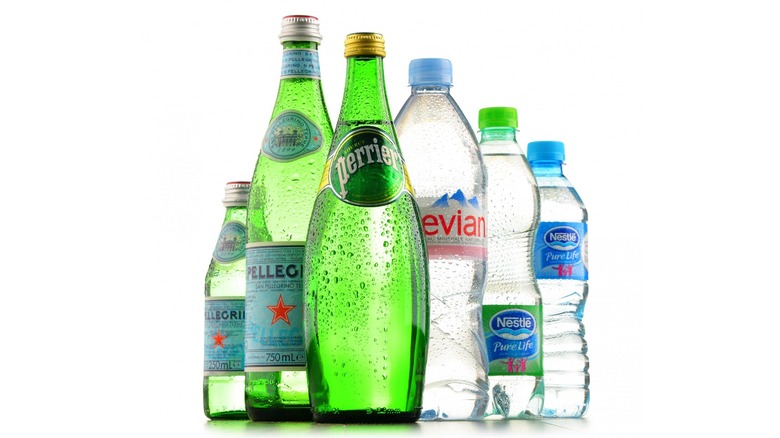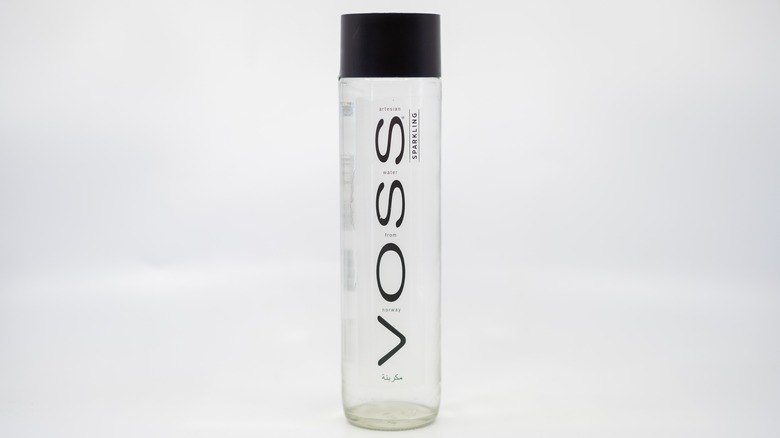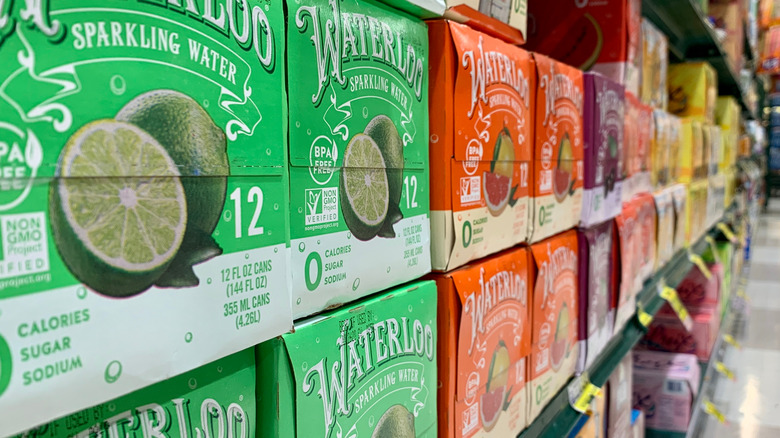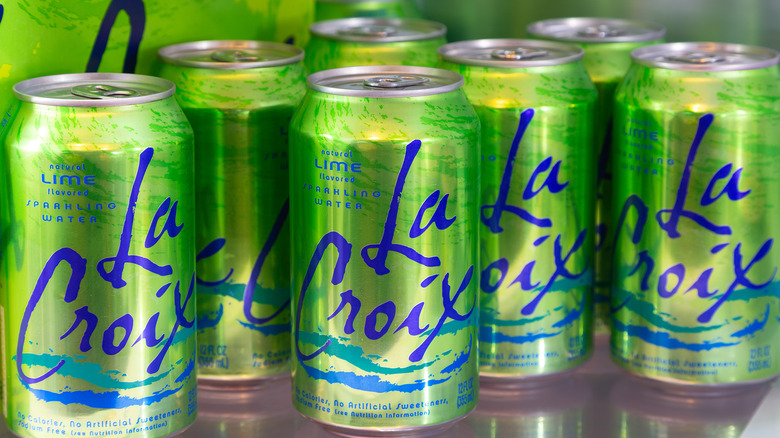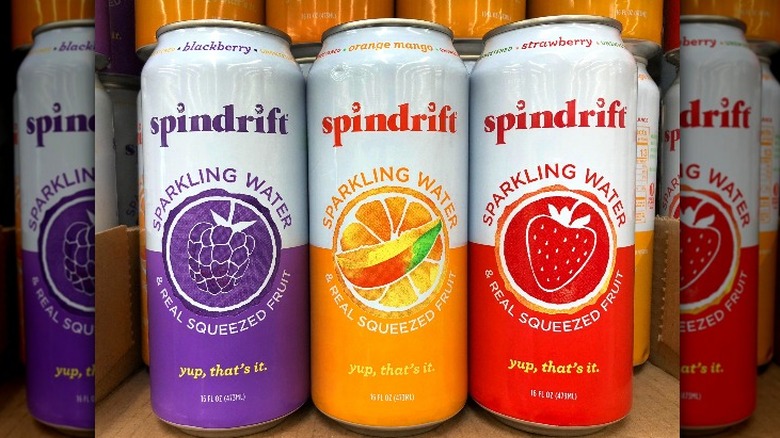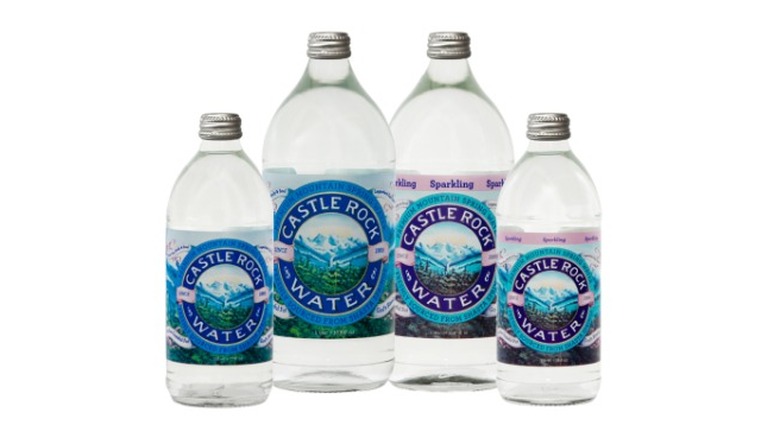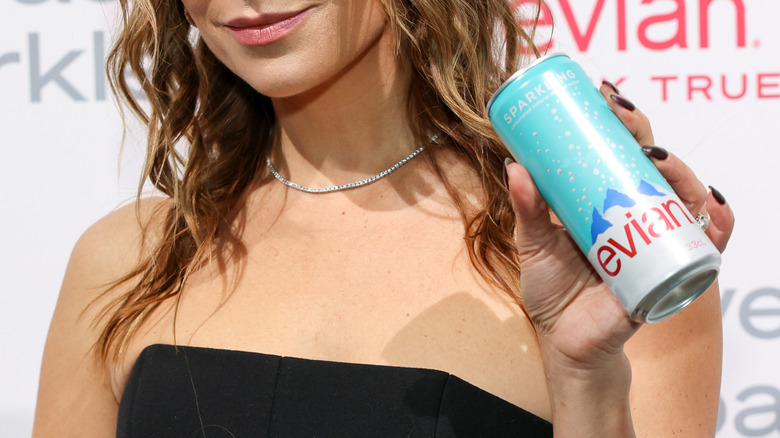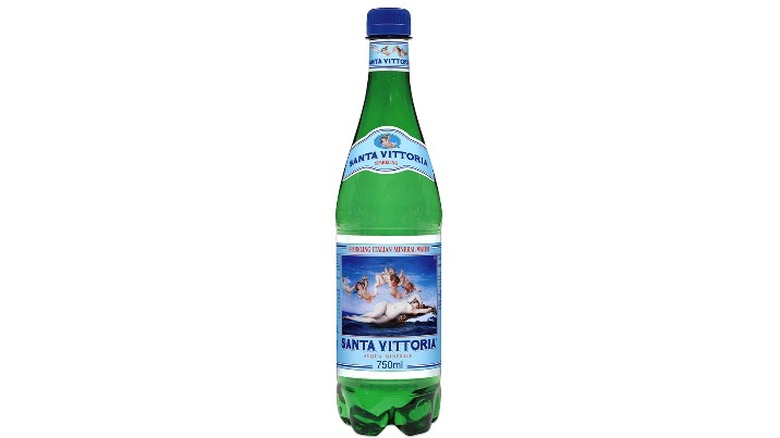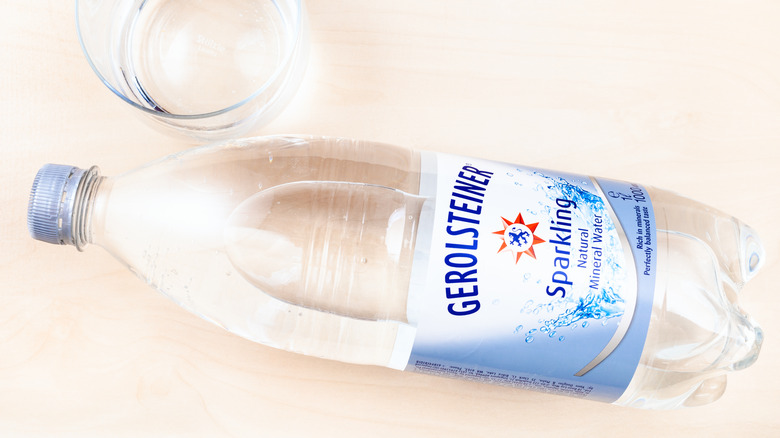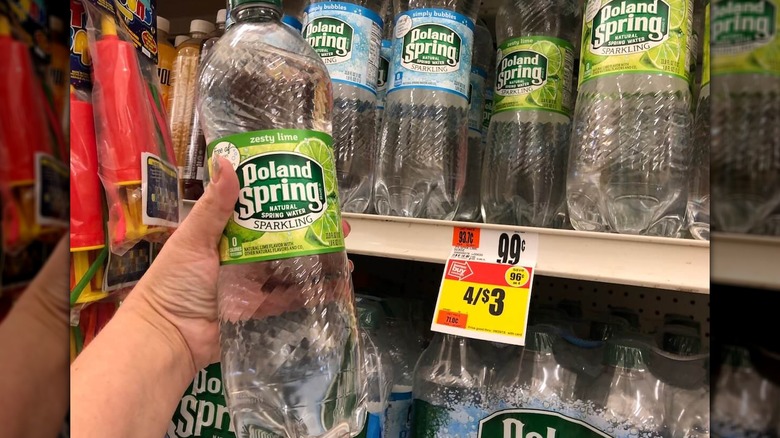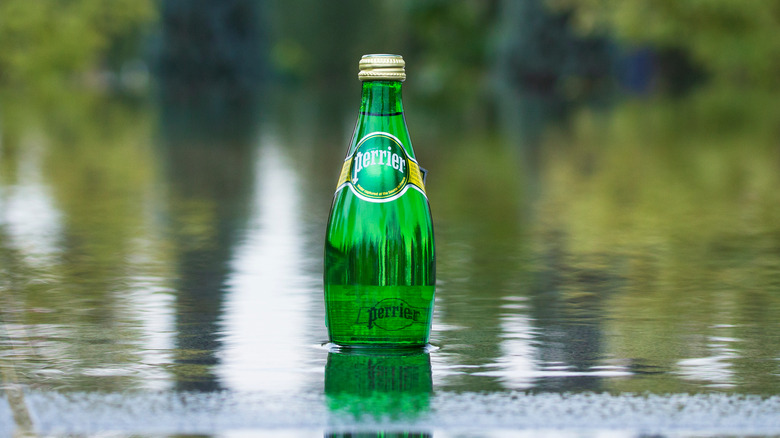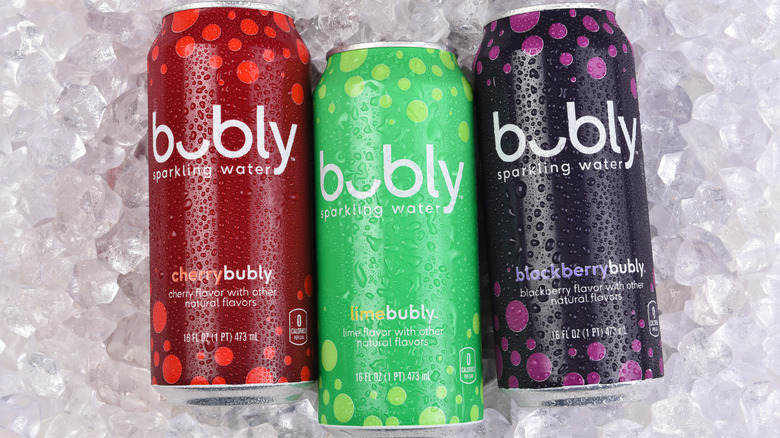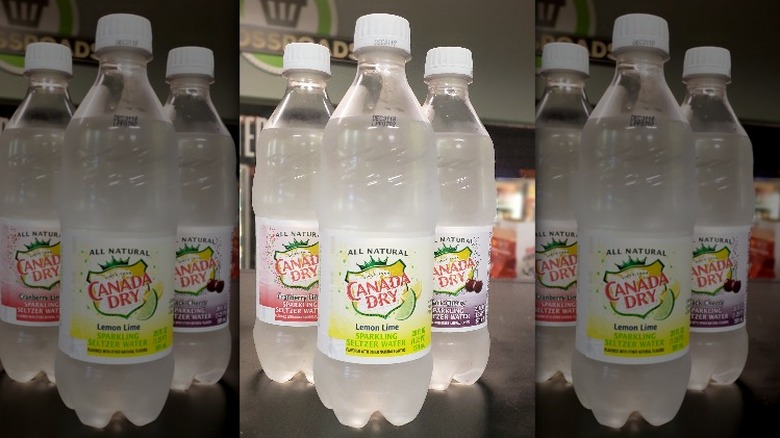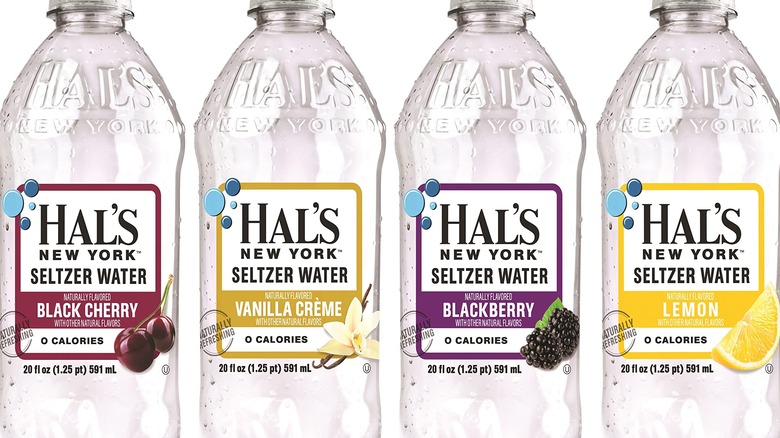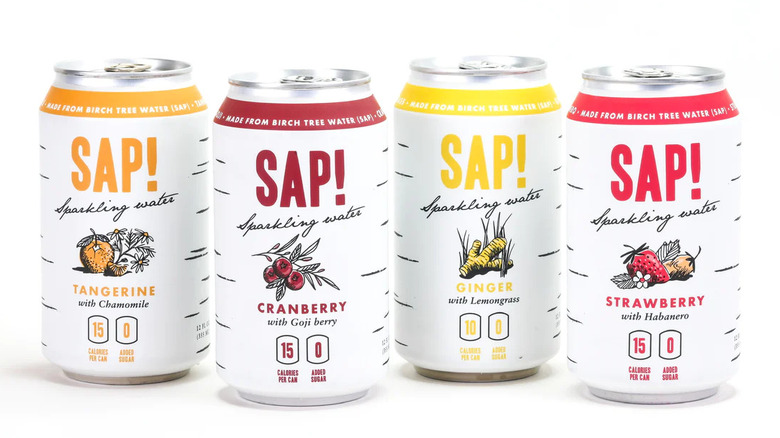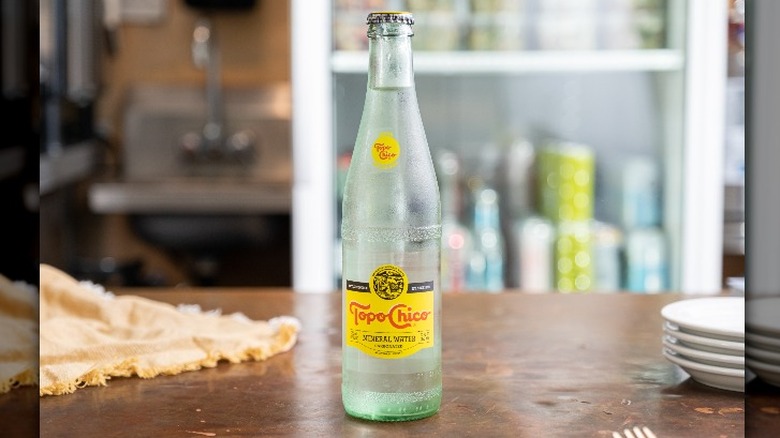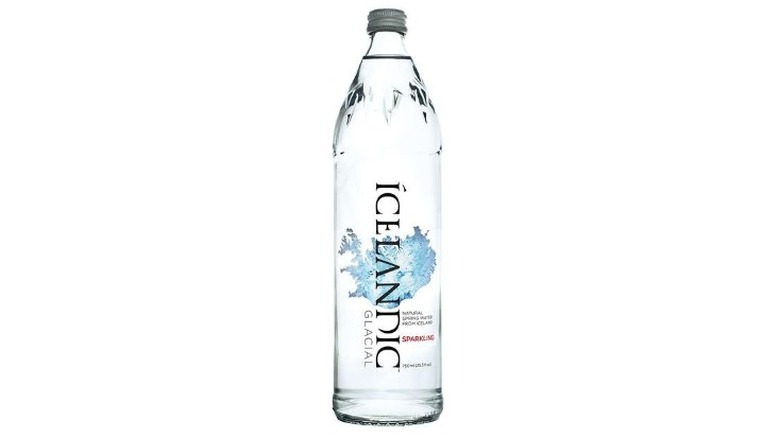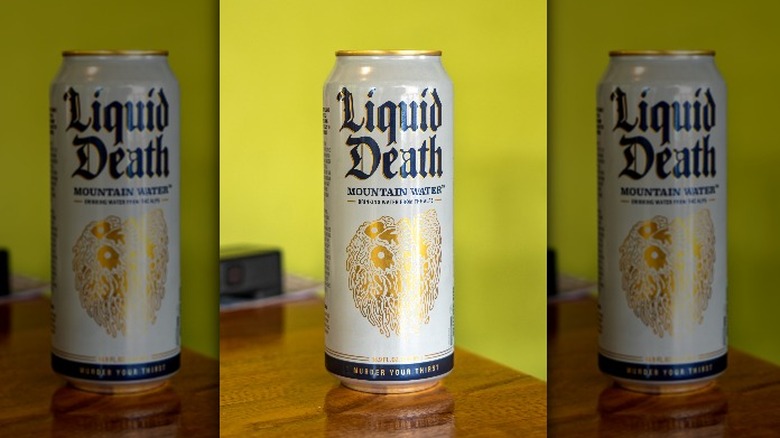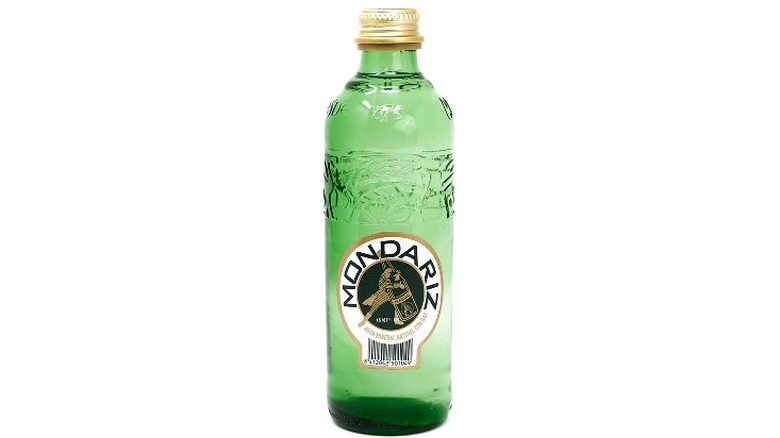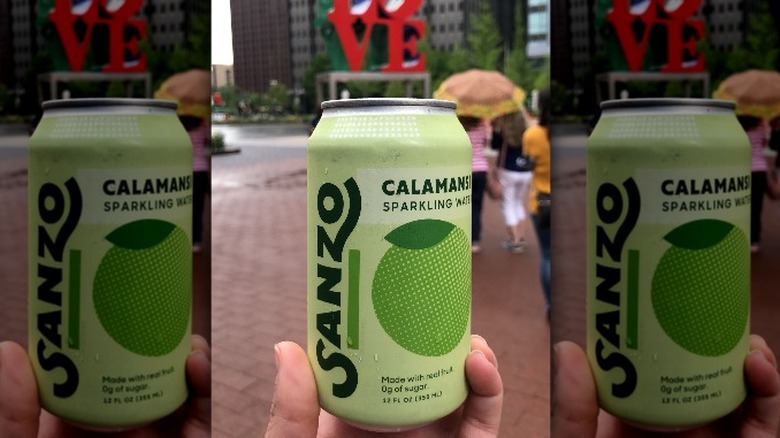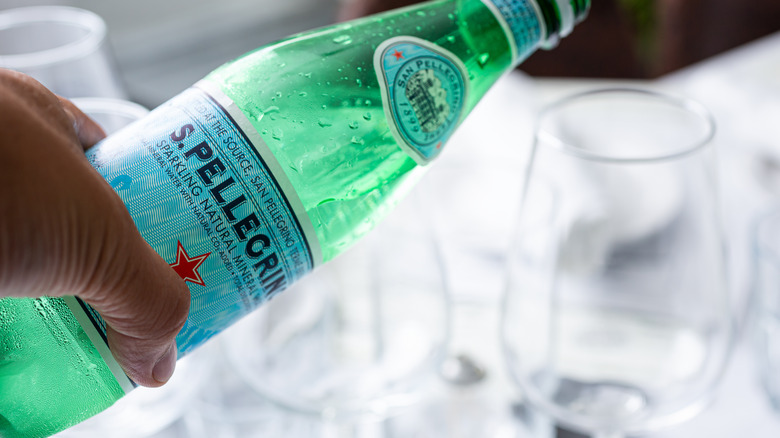21 Best Sparkling Water Brands Of 2023, Ranked
We may receive a commission on purchases made from links.
In the 19th century, towns in Europe, such as Bath in the U.K. and Vichy in Italy, became known for their water sources, which were thought to have healing capabilities. It was said that the water — both still and sparkling — contained minerals and vitamins that could heal skin conditions, rheumatoid arthritis, injuries, and more. Health tourism quickly became popular as people began traveling to these towns to bathe in the nourishing waters (per Royal College of Physicians).
Many companies sought to further profit from the water sources by bottling the naturally sparkling water and selling it on the national and international markets. The popularity of these healthy and crisp beverages grew rapidly. The sparkling water (also known as soda water or seltzer) that was bottled at notable sources, such as San Pellegrino's Val Brembana, soon gained international acclaim and became a status symbol of health, taste, and class.
The success of bottled sparkling water on the international drinks market has endured throughout the decades, with the beverage becoming increasingly common and readily available around the world. In 2019, The New York Times reported that both supply and demand for the beverage had never been higher. Consumers now have many options when it comes to choosing sparkling water, with brands offering a variety of styles, such as fruity flavors, flavorless, high or low minerals, sweetened, and unsweetened.
21. Voss
Voss is perhaps the most prominent example of how water, sparkling or still, can be sold not as a product but as a lifestyle. As reported by Beverage Daily, the associations of luxury that people make with the brand are not by chance. Rather, they are the product of marketing and collaboration campaigns that led to the cylindrical glass and silver bottle becoming synonymous with style and elegance.
Unlike other premium sparkling waters, Voss does not have high levels of minerals and markets itself as having an unadulterated taste (per Voss). As reported by Voss in a water quality report, these low mineral levels also ensure the water doesn't alter the flavor of accompanying food or wines, thus making Voss suitable for any dining occasion. However, for those seeking a little more flavor, the company has also released a range of flavored sparkling waters, including lime mint and lemon cucumber. These flavor-filled alternatives can be enjoyed on their own or used as a mixer in cocktails.
While Voss Sparkling is marketed with the brand's trademark elegance and the water itself is crisp and pure, the significantly higher price point in comparison to other brands is what landed it at No. 21 on this list.
20. Waterloo
Waterloo launched in 2017 and grew nearly 3,000% by 2019, as reported by Austin Monthly. The brand prioritizes flavor above all else and has an in-house team dedicated to creating new combinations. When building flavor profiles, the team experiments with more than 30 flavorings over a nine-month time period (per Waterloo).
This process is very important to the company, as explained by Jeff Arnold, the chief operating officer at Waterloo. "We obsess and agonize over every flavor. We want to create an experience where the flavor builds to a lasting finish," he said. "And that takes way more time than you'd imagine. It took over a year just to create something like our coconut" (via Austin Monthly). Waterloo's dedication to building unique flavors is paying off as the company has built a strong presence in a highly competitive market, a fact reflected by the brand's ranking on this list.
The company treats carbonation as one of the ingredients as well. This ensures that even its unflavored sparkling water — sold as original — is designed with taste and mouthfeel in mind. By controlling how and to what degree the water is carbonated, the company has built a drink with a silky taste and feel (via Brit + Co).
19. LaCroix
LaCroix caused a huge rise in the visibility and popularity of sparkling water during the mid-2010s, as noted by Mary H.K. Choi in an essay published in The New York Times in 2015. Many, including The Guardian, attribute some degree of this success to the sparkling water's branding. LaCroix's packaging is vivid and playful, a far cry from the clean, sophisticated, and minimalist branding associated with premier sparkling waters, such as Voss or San Pellegrino.
The label isn't the only thing that speaks to the new wave of sparkling water consumers — the flavors do, too. LaCroix offers an exciting take on flavored sparkling water, featuring unique flavors, such as pamplemousse and limoncello. It is due to these thrilling flavor combinations and the brand's enduring popularity that we ranked LaCroix a respectable No. 19 on the list.
The company's unique approach to marketing and flavoring has had even wider implications for the sparkling water industry. The brand is seen as a key driver of the sector's future growth, which is predicted to reach a value of $67.6 billion by 2030, as reported by InsightAce Analytic (via PR Newswire).
18. Spindrift
Spindrift, a Massachusetts-based company, has carved a niche for itself by only using real fruit to flavor its range of sparkling waters (per Mass Live). In an interview with Markets Insider, Chad Palma, president of sales at Spindrift, noted how using real fruit in their water has benefited the company. "At Spindrift, we believe that authenticity and real ingredients are what make us better," he said. "We are committed to bringing transparency to consumers in a way that tastes as refreshing as it feels. Our real ingredient message is certainly resonating with consumers, and we are gaining distribution in channels where they are actively seeking these types of products."
Spindrift sparkling water is available in refreshing flavors, such as blackberry, orange mango, and strawberry. Consumers' growing desire to buy products made with real ingredients has led to Spindrift products being stocked in major retailers across the United States, including Starbucks, Whole Foods, and Kroger, as reported by Spindrift (via PR Newswire). The unique approach to flavoring that the company has adopted marks the brand as a cut above other flavor-centric competitors, such as LaCroix and Waterloo.
17. Castle Rock
Perhaps the most notable difference between sparkling water brands is their focus on flavor versus water quality. For example, LaCroix and Spindrift spend little time expounding on where their water is sourced from or why it is of such high quality. Rather, the water is seen more as a vehicle for carrying their popular flavorings. Castle Rock, on the other hand, starkly contrasts this sentiment by proudly highlighting the origins of its sparkling water, the glacier-to-glass nature, and the fact that it remains untouched by human hands until bottling (per Castle Rock Water Company).
Castle Rock's water is sourced from the springs of Mount Shasta's glacier in Dunsmuir, California. Over the course of 100 years, the water is slowly filtered by numerous layers of rock, such as granite. The high quality of water this process produces is attested to by the company's success, including the 2014 best bottled award at the Berkeley Springs International Water Tasting.
The purity in both the origin and flavor of Castle Rock marks it as a premium sparkling water and deserving of a place on this list. However, the company's limited retail presence and lack of global distribution mean it falls short when competing for higher positions, a fact that could easily change in the future.
16. Evian
Evian launched in the early 19th century and has become a giant in the water industry. The company's water begins as raindrops that fall on the Gavot plateau, a glacial plateau in the French Alps. As the water makes its way down the mountain, it's filtered by a myriad of rock formations before reaching the town of Evian-Les-Bains. During this filtration process, the water achieves a low mineral composition, neutral pH balance, and a moderate level of calcium. These factors contribute to Evian water having a nearly flavorless taste (via Evian).
With the company boasting more than 200 years in operation, it may come as somewhat of a surprise that Evian only launched its sparkling water in 2022 (via The Drum). However, the company seems confident about the sparkling water's success. Dillon McEvoy, head of marketing at Evian, said, "This is the start of a new chapter for our iconic brand, and we're sure that Evian Sparkling, standing out for its true purity and freshness with just the right amount of bubbles, will be just as popular with consumers across the UK."
The fact that Evian produces such pure, refreshing water already marks it as a leading competitor in the sparkling water industry. However, it's the company's penchant for attractive design, potential for worldwide distribution, and unerring consistency that led to its ranking on this list.
15. Santa Vittoria
Water companies are inherently connected to the well-being of the Earth because their products are a natural resource. This has led to many water companies taking an active role in protecting both their water sources and the general well-being of the planet (via Climate Action). Santa Vittoria is one such company that is looking out for the environment by offsetting more than 46,000 tons of carbon dioxide emissions. In an interview with Hotel Management, brand manager Joshua Passaro said, "We aim to deliver Santa Vittoria from the source in northern Italy to consumers with as little environmental impact as possible. We do this by offsetting the carbon emissions generated from the importation of Santa Vittoria mineral water into Australia and New Zealand."
Santa Vittoria water is sourced from the Dolomite Mountains in northern Italy near the city of Bergamo (per Hotel Management). The water is low in minerals and sodium, and no sugars are used (per Santa Vittoria). The company's focus on producing pure products earned it a place on the list, a position that would undoubtedly be higher if the water was more widely available.
14. Gerolsteiner
Several sparkling water brands market their product as low in minerals and thus free from any flavors that may taint the water. However, Gerolsteiner celebrates the high mineral content in its water and the associated health benefits.
The mineral water is sourced from the Volcanic Eifel region in western Germany. One liter of the German brand's sparkling water contains more than 2,500 milligrams of minerals and elements, including calcium, potassium, and magnesium. Because the minerals are dissolved in the water, your body is able to absorb them more quickly than when taking a vitamin pill.
Despite providing a significant amount of a person's daily mineral requirements, Gerolsteiner sparkling water presents a balanced and light flavor profile. While other vitamin-rich waters often have a bitter or salty flavor, the company notes that the unique balance of minerals in a bottle of Gerolsteiner creates a "pleasant, harmonious taste without any dormant individual mineral notes." It is this combination of health-boosting mineral levels and a pleasing taste that makes Gerolsteiner sparkling water rank on this list.
13. Poland Spring
Poland Spring, a beverage brand owned by Nestlé, differentiates itself by highlighting the quality of its spring water. This water is sourced from numerous natural springs dotted around Maine, each meeting strict Food and Drug Administration standards. To become one of the brand's sparkling products, the water undergoes a process of carbonation before being finished with natural flavorings.
Poland Spring has sought to capitalize on the growing popularity of sparkling waters by releasing an extensive range of flavors. While many of these sound appealing, the water is best appreciated in its unflavored form. This was highlighted by one customer on Walmart: "I really love this Poland Spring Simply Bubbles Water. It is a treat for me to have, bc I am a Diabetic; instead of plain water. It does not spike my sugar, unlike flavored seltzer water, honestly. I love the flavor, which it tastes like it has minerals in it. A great product for Poland Spring's line-up and an excellent alternative to regular spring water."
12. Perrier
Perrier epitomizes the luxury many people associate with sparkling water. This association is partly due to the brand having a long history of being served to the aristocracy, as well as having received royal warrants from King George V and Edward VII (per The Guardian). Indeed, throughout the 20th century, Perrier was frequently referred to as the "champagne of table water" (via Perrier). Branding, including advertisements created by Salvador Dali and Andy Warhol (per Architectural Digest), helped to cement the brand as a leader in the sparkling water industry.
Perrier water is sourced in Vergeze, France, and has highly acidic pH levels as well as high levels of nitrate (per Fine Waters). The sparkling water is available in a variety of styles, such as unflavored, pineapple mango, watermelon, and peach. The company also has a line of energy sparkling water made with "plant-based caffeine" — yerba mate and green coffee extracts.
Despite not making it to the top half of our list, Perrier can nevertheless take pride in its prestigious history. It is one of the quintessential sparkling water brands and, as such, will always carry a special significance.
11. Bubly
Growing awareness of the negative health impacts associated with sugary soda consumption has driven consumers towards alternatives, such as sparkling water. Large beverage companies like PepsiCo have adapted to this changing consumer landscape by launching new sparkling water brands that can utilize the company's immense design, marketing, and sales expertise. Bubly, which was launched by PepsiCo in 2018, is one such brand.
Bubly has been an immense hit thanks to an appealing design that contributed to the cans going viral. Of course, what's inside matters, too. Bubly contains no calories, sodium or sweeteners, making it an extremely attractive choice for those seeking healthier options. This was highlighted by a review one person left on Amazon: "I have really enjoyed Bubly. I have been trying to cut out soda for the obvious terrible implications from it and sampling the market for different zero sugar/sweetener and calorie drinks [...] The flavor on these is great. I think they have a good smell, which makes your senses feel like you aren't just drinking a lightly flavored sparkling water."
Bubly products contain only two listed ingredients: carbonated water and natural flavor. This latter term is somewhat contentious; natural flavors have to be derived from plant or animal sources, but can contain an array of preservatives and solvents. PepsiCo does not reveal what the natural flavors consist of, as this is proprietary information. Consequently, consumers do not know exactly what they are drinking.
10. Canada Dry
Canada Dry is another brand that is quick to celebrate its zero calorie, unsweetened nature while revelling in the ambiguity provided by the term "natural flavors." Despite this, Canada Dry remains one of the most recognized brands in the sparkling water market. While a large degree of this fame is due to the brand's famous ginger ale, Canada Dry's sparkling water garners considerable praise in its own right.
Many sparkling water brands such as LaCroix and Bubly rely on a huge array of flavors in order to maximize reach. Canada Dry, in comparison, only produces four. The most prominent of these is Canada Dry's flagship original sparkling water, a drink that does not contain any natural flavors. This product is defined by a crisp, clean taste, as one customer highlighted on Amazon: "I love this brand of seltzer water_ I drink it cold & straight_ most people drink soda's full of sugar or syrup, but I drink Seltzer Water for the refreshing fizzy effect without all the thick diabetes causing corn syrup_ This stuff is crisp & light."
A downside to Canada Dry sparkling water is that it is significantly more expensive than many other brands. A twelve pack of the original can easily cost $7.99. For comparison, a twelve pack of Bubly can be bought for less than half that price.
9. Hal's New York
In pursuit of purity, food brand Hal's New York filters its water five times using a reverse osmosis filtration system. This is not the only way Hal's New York ensures its sparkling water is impeccably clean; a polishing system and ultraviolet treatment also ensure that almost no bacteria or microbes enter the bottles.
Although Hal's New York clearly values the purity of its water, this is not the defining feature of the brand. A distinctly New York-centric approach takes that honor for reasons Lewis Hershkowitz, co-founder of Hal's New York, explained to Long Island.com: "We had done some research and there was room for another seltzer in the New York market, and we realized that none of the other brands out there really had that 'New York' aspect to it. They were mostly focused on national brands like Seagram's, Schweppes, and Canada Dry."
Hal's New York sparkling waters come in a variety of flavors, ranging from black cherry to vanilla creme. While this wide selection ensures there is a sparkling water for every taste, all Hal's products have a reputation for being heavily carbonated. This is somewhat divisive amongst customers, one of the main reasons why this brand did not rank higher on our list.
8. Sap!
Hailing from Vermont, Sap! is a brand that takes a wholly unique approach to sparkling water. Instead of adopting the seemingly ubiquitous "zero calories, no added sweeteners" route, Sap! celebrates the inclusion of its namesake ingredient, tree sap. While the inclusion of ingredients like birch sap results in a can of sparkling water that contains 25 calories and six grams of sugars, to assume it is less healthy than other brands on this list would be a mistake. That's because it actually brings many benefits to the product, including an abundance of antioxidants and anti-inflammatory properties.
The company also produces a seltzer that contains maple sap. This beverage surprises people with its subtleness, for reasons explained by a reviewer on Amazon: "Do not expect a strong maple taste, as that's not what this is. If my memory serves me correctly, it takes 30-40 gallons of maple sap to make one gallon of syrup, so the flavor profile of sap is quite subtle. I happen to love the taste, and I found it very refreshing. It was tough rationing my case to make it last, and I found myself drinking several cans a day at times." All of Sap!'s beverages demonstrate this subtlety, although options such as Ginger-Lemongrass Sparkling Water and Tangerine-Chamomile Sparkling Water offer busier flavor profiles for those that prefer bold tastes.
7. Topo Chico
Topo Chico has gained an avid following in Texas, where the sparkling water dominates retail sales, as reported by IRI (via The New York Times). According to those interviewed by the publication, a large part of the brand's appeal is the liquid's distinctive mouthfeel. Paul Wise, a scientist whose work focuses on the perception of chemical stimuli, hypothesizes that this may be due to Topo Chico having lower carbon dioxide levels than other sparkling waters (per Mic). The lower levels cause the bubbles to fizz on the tongue, which makes it feel more like a soda, as opposed to the harsher bubbles traditionally associated with sparkling water. The distinct mouthfeel of Topo Chico is the feature that has cemented its position so high on this list; there is simply nothing quite like it. Thanks to the effervescent bubbles, Topo Chico provides a level of refreshment unrivaled by its competitors.
Since the brand was acquired by The Coca-Cola Company in 2017, Topo Chico has become increasingly available across the U.S. and sales have risen dramatically (via Bloomberg). Looking to build on the massive demand for the brand, Coca-Cola announced its first alcoholic drink, Topo Chico hard seltzer. As reported by Vegconomist, the hard seltzer has enjoyed great success in its European and U.S. launches alike.
6. Sound
Sound is a brand that has upended the sparkling water industry by producing a wholly unique range of products made from natural teas, botanicals, organic extracts and sparkling water. These beverages only use USDA-certified organic extracts. All ingredients are listed on the can. Furthermore, no sugars or sweeteners are used resulting in healthy and natural yet still flavorsome products. One reviewer highlighted this unique taste on Amazon: "Totally worth the price! It's fizzy, unsweetened, and has delicious flavor! [...] For the chamomile specifically, the flavor is fairly strong which is hard to achieve with chamomile and fits the description perfectly: it's floral and has a strong vanilla taste as well."
By using a variety of teas, Sound varies not only the flavor of its products, but also their uses. The Tangerine with Lemongrass and Green Tea sparkling water contains 45 milligrams of caffeine, making it a great choice to fight the midafternoon slump. Other products like the Grapefruit with Lavender and Ginger Tea contain no caffeine, making them suitable for every time of day and night.
5. Icelandic Glacial
Many types of sparkling water are slightly acidic, frequently sitting between 3 and 6 on the pH scale (per CBC). This acidity can cause tooth enamel to wear away, leaving teeth weakened and vulnerable, as reported in The Korean Journal of Orthodontics. In contrast to this industry norm, Icelandic Glacial sources its water from Iceland's Olfus Spring, which has a pH level of 8.4, "making it naturally alkaline" (via Icelandic Glacial).
Aside from aiding dental health, the alkalinity levels of Icelandic Glacial sparkling water can have several other physiological benefits. Annals of Otology, Rhinology & Laryngology notes that by drinking water that is more alkaline than pH 7.4, individuals can alleviate the uncomfortable symptoms of reflux disease. This is because the alkaline water denatures pepsin and creates a greater acidic buffer. Furthermore, a study published in the Journal of the International Society of Sports Nutrition found that highly alkaline water can improve blood viscosity post-exercise, boost blood flow, and aid in rehydration.
The myriad of health benefits provided by Icelandic Glacial is why this sparkling water comes in at number 5 on our list. No other sparkling water typifies the industry's longstanding association with health and wellness better than Icelandic Glacial. The brand's water is a testament to the enduring relevance of natural sparkling water to our health.
4. Liquid Death
While other sparkling water companies use cute designs and claims of purity to win over customers, Liquid Death — a hugely successful sparkling water brand — uses comedy. This is not the slapstick humor of earlier generations, but the unique, meme-fuelled, nihilistic humor of Gen Z, a type of humor that plays extremely well on social media.
That being said, Liquid Death is also one of the best brands at tying together marketing, design and product. Take for example Liquid Death's key principle of sustainability. Not only is this mentioned throughout the brand's marketing, but it is also the key reason why Liquid Death is sold in its iconic tallboy cans. As CEO Mike Cessario explained to Forbes: "Aluminum cans are infinitely recyclable and I think everyone knows that plastic bottles are like the new tobacco. Everybody's trying to get rid of them [...] aluminum and metal is easy to melt down into big bricks and then resell at a profit. So it's really only aluminum that's consistently getting recycled, and that's the high level of what the brand's all about and what we're trying to do." What's more, the can fits perfectly into Liquid Death's punk aesthetic, by imitating the shape of beer cans as opposed to traditional sparkling water cans.
Finally, the brand is backed up by a good product. Liquid Death's sparkling water only contains low levels of carbonation, making it less bitter and thus approachable for a wide range of audiences.
3. Mondariz
To receive a diamond award from the International Taste Institute, a product must be awarded a three-star superior taste award for seven years during a 10-year window, as highlighted by Aguas de Mondariz. Mondariz has achieved this exceptional feat not once but twice, with both the still and sparkling waters receiving this coveted award.
As with many heritage water brands, the springs that provide Mondariz with its product rose to fame as a spa destination. In the early 1900s, Dr. Domingo Blanco Lage discovered the springs and noted their healing powers on the local people. He began recommending a soak to his patients (per Fine Waters), and before long many notable visitors frequented the healing springs in Mondariz Balneario in Spain (per Vichy Catalan). The water sits in an aquifer for 60 to 150 years and is filtered by layers of granite, which gives it a "unique texture and flavor," per the site.
Mondariz has received multiple awards, such as the International Taste & Quality Institute's diamond taste award in 2015 and 2016, and superior taste award from 2009 through 2012. The company's exceptional taste is what landed it the third spot on our list.
2. Sanzo
The sparkling water industry has been dominated by the same flavors for years. Grapefruit, lime, strawberry — the list goes on. Sanzo, a sparkling water company launched in 2018, seeks to change this by highlighting less Western-centric flavors through alternatives like yuzu and calamansi. Founder Sandro Roco explained this approach to Eater: "What we're attempting to do, and having a bit of success in, is shaping the way folks think about this country and think about representation. These flavors had not yet been represented on mainstream shelves or were relegated to a certain aisle of the store. We're having conversations that are changing that dynamic."
Aside from flavors, Sanzo also impresses thanks to transparency. Instead of using the ambiguous term "natural flavors", each of Sanzo's products have all ingredients clearly listed. This degree of information is a rarity in the flavored subcategory of the sparkling water industry — one that health-conscious consumers will be happy about. What's more, Sanzo's sparkling waters do not contain added sugars, calories or sodium.
Finally, as a minority-owned business, Sanzo uses its products to celebrate Asian American accomplishments. A current example is a special product celebrating the 10th anniversary of ex-NBA player Jeremy Lin's iconic streak of basketball performances, known as Linsanity. This uplifting approach is a refreshing, new aspect to sparkling water, one we hope to see more of.
1. San Pellegrino
San Pellegrino is the epitome of sparkling water's potential for elegance and taste, with the iconic bottles sitting comfortably on tables in the world's finest restaurants. This is not only because San Pellegrino is a brand that oozes sophistication but also because the water itself is a perfect match for the high-quality gastronomy served within these establishments. It is because of this that The World's Fifty Best Restaurants serves San Pellegrino sparkling at its annual awards evening.
The company takes its pairings seriously and even created a water codex to teach restaurants how to pair their sparkling waters with various dishes. As a general rule, the strong mineral notes of San Pellegrino work extremely well with equally powerful wines. The distinctive, crisp nature of San Pellegrino can even be used to cut through a vintage port, as noted in the codex.
However, San Pellegrino need not be confined to the realm of fine dining alone. This subtle sparkling water can be enjoyed in a myriad of settings and features thirst-quenching carbonation, salinity, and an iconic, bitter aftertaste that make it the perfect drink to enjoy after a long day in the sun (via San Pellegrino). It is this versatility that led to San Pellegrino earning the top ranking on this list.
